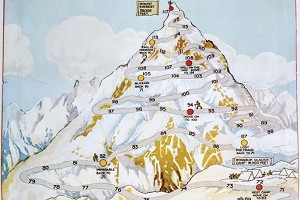
Following the death of Queen Elizabeth II, we look back at the news scoop that launched a life-long and historic connection between Mount Everest, Her Majesty and the outdoor/adventure world.
On 2 June 1953, Her Majesty Queen Elizabeth II was crowned. As throngs of people lined the procession route to Westminster Abbey in the rain, news rang out over a loudspeaker that the first ascent of Everest had finally been achieved on 29 May by two members of a British expedition team.

4,500 miles away on Everest's Western Cwm at an altitude of 5,400 metres, four and a half hours ahead of London time, five men lay in a tent and listened, fatigued but rapt, to radio coverage of the coronation. Four days earlier, one of those men, the New Zealander Sir Edmund Hillary, had stood on 'the roof of the world' at 8,848m on the summit of Everest alongside Tibetan-born Tenzing Norgay.
It was thanks to the cunning and speed of a journalist at The Times that these two major historical events coincided and would forever be inextricably linked.
Upon confirming two successful summits, 26-year-old Jan Morris, then known as James Morris, correspondent for The Times, scribbled a pre-arranged ciphered message to protect his scoop from lingering reporters in the foothills. The Times was an expedition sponsor, with exclusive reporting rights. Morris couldn't risk the news being intercepted.
SNOW CONDITIONS BAD STOP ADVANCED BASE ABANDONED YESTERDAY STOP AWAITING IMPROVEMENT
ALL WELL! //SUMMIT OF EVEREST REACHED ON MAY 29 BY HILLARY AND TENZING. ALL WELL!
'[Morris], perhaps more than the rest of us at that moment, realised the faint but glorious possibility of getting the headlines home in time for the Coronation of Her Majesty the Queen,' expedition leader John Hunt would write later that year in The Ascent of Everest. Morris and Michael Westmacott immediately descended in a frenzy to Base Camp—a 'dash into the darkness', which cost Morris a toe nail.
A relay of runners rushed the message in padlocked bags from Everest Base Camp to a radio post at Namche Bazar, before operators forwarded the news to the British Embassy in Kathmandu. In his haste, the British Ambassador in Nepal almost relayed the wrong names back to Britain.
Cultural, national and historical significance aside, HRH Prince Philip, Duke of Edinburgh's patronage of the 1953 expedition meant that the Royal Family had a vested interest in its outcome. John Hunt had visited Buckingham Palace shortly before leaving for Everest to brief the Duke of Edinburgh on his team's plans. 'It was vastly encouraging that we should be watched with interest by one who places such value of the spirit of enterprise and high endeavour,' he wrote in his book.
Queen Elizabeth was informed of the ascent at Buckingham Palace on the evening before her coronation—'just after dinner, in a red dispatch box,' Morris later revealed in an article.
The two-fold celebrations made international headlines:
'2 OF BRITISH TEAM CONQUER EVEREST; QUEEN GETS NEWS AS CORONATION GIFT; THRONGS LINE HER PROCESSION ROUTE; HIGHEST PEAK WON.' - The New York Times, 2 June 1953
The Daily Express was less sanctimonious: 'All this – and Everest too!'

In The Ascent of Everest, Hunt wrote about the surreal situation of listening to the news via the wireless at Advanced Base Camp on 2 June 1953:
On that same day, back in England, a young Chris Bonington—who would go on to make four expeditions to Everest—was playing his own role in the coronation celebrations.
"I had just joined the Royal Air Force College, Cranwell and was in a parade to celebrate Queen Elizabeth II's coronation when it was announced at the beginning that Everest had been climbed by a British expedition," he said. "At the time I wasn't much moved as my passion was climbing new routes and making first ascents in the Alps."
It was not until a few years later when Bonington visited the Himalayas that Everest inevitably became his principal ambition. While leading several expeditions with the goal of selecting the two strongest climbers for the first summit bid, he set his personal ambition aside. Bonington finally reached the summit in 1985 as an 'ordinary member' of a Norwegian expedition—feats which, alongside numerous other significant ascents, led to honours from Her Majesty for contributions to mountaineering, including a CBE, a knighthood and a CVO.
Following her death, Sir Bonington paid tribute to the Queen. "She was the most remarkable person whom I have ever met," he said. "We as a nation owe a huge amount to her. She had a lovely sense of humour and a kind twinkle in her eye."
***
Throughout her seventy-year reign, Queen Elizabeth and HRH Prince Philip attended numerous commemorative events hosted by the Alpine Club and the Royal Geographical Society celebrating the 1953 expedition, spanning from the first showing of the film of Mt. Everest in October 1953 in London to the 60th anniversary of the ascent in 2013. Philip was the patron of the Mount Everest Foundation for many years and was an Honorary Member of the Alpine Club, writing the foreword to George Band's history of the Club in Summit: 150 Years of the Alpine Club.
'With her husband HRH Prince Philip, she attended a number of Alpine Club events, including our 1957 centenary celebrations,' the Alpine Club wrote in a tribute. 'She was also a regular attendee at anniversary celebrations for the first ascent of Mount Everest adding, in the words of former AC President Stephen Venables, "lustre" to those occasions.'
Venables met The Queen many times, first at a fundraising event and, a few years later, at an event at Buckingham Palace in 2011 where "all the usual suspects" from adventure and exploration circles were invited to meet Her Majesty.
"These events were huge fun, and strangely moving—particularly the 60th anniversary in 2013, with David Attenborough interviewing the now very elderly remaining survivors of the 1953 expedition," Venables said. "Perhaps it was just superlative professionalism, but at the party afterwards The Queen seemed genuinely to be enjoying herself and particularly enjoyed teasing Chris Bonington about the time he broke his leg on Lochnagar, just above her holiday home."
For the 60th anniversary event at the Royal Geographical Society, Venables had the "nerve-wracking job" of keeping Chris Bonington, Doug Scott, Peter Hillary and Jamling Tenzing in line for the precise moment of Her Majesty's entrance.
"Doug almost stuck to his time slot, but then got carried away by a priceless impromptu joke about corgis on the Hillary Step," Venables recalled. "He overran by a minute, so I had to cut poor Peter Hillary short to welcome The Queen onto the stage. We kept Jan Morris, by now the sole survivor of the 53 expedition, for last, and she rose splendidly to the occasion with two minutes of beautifully scripted, eloquent, witty, poetic nostalgia. A staunch Welsh republican, but also a child of the British Empire, she concluded with a few remarks about the reign she had helped serendipitously to launch, peered into the darkened auditorium, looking for the diminutive monarch now sitting in the audience and asking, 'Where is she? … Ah, there you are … well you've been a jolly good Queen.'"
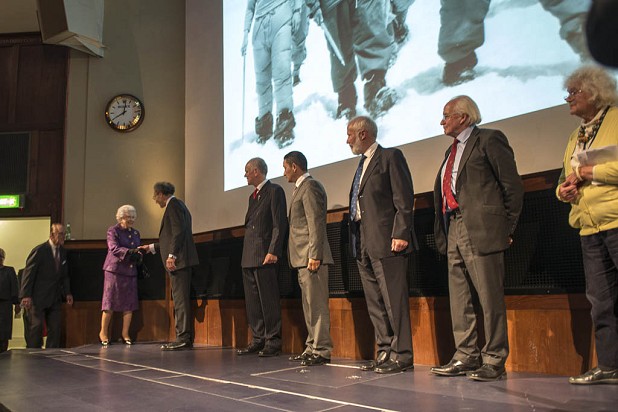
Also present at the 60th anniversary was Piolet d'Or winner, Mick Fowler, who met the Queen while showing her Alpine Club artefacts. "She must have lost count of how many similar events she had attended but, at the age of 87, I was struck by how sprightly she was and how interested she was in her surroundings," he said. "She peered closely at the artefacts, taking it all in without saying anything while Philip, true to form, gave honest feedback along the lines of 'The captions are too small—I can't read them.'"
British mountaineer Rebecca Stephens remembers her encounters with the Queen fondly. "I count myself very lucky to have met her at Everest anniversary events through the years," she said. "As we prepare for next year's 70th anniversary of the first ascent, there is a gaping hole in the shape of those pioneering climbers on the 1953 team who together ensured Hillary and Tenzing stood on the top, and now Her Royal Highness Queen Elizabeth II. She'll be missed, but her legacy, entwined with the enduring legacy of the highest mountain in the world, lives on."
***
"I am not sure whether The Queen—unlike her husband—really 'got' mountain exploration," Venables said, despite her gracious commitment to attending events, and her having two mountain ranges named after her: the Queen Elizabeth Ranges in the Canadian Rockies, a 1953 coronation gift, and the Queen Elizabeth mountains in Antarctica, named in her patronage of the 1956 Commonwealth Trans-Antarctic Expedition.
But the Queen's passion for the outdoors in general was widely known. She was documented in film and photographs walking with her dogs and riding her horses around the Balmoral estate and in the Deeside hills, including the 1,155-metre Munro Lochnagar, where—ironically, having been sufficiently sure-footed on Everest, Annapurna II, Changabang and other formidable peaks—Sir Chris Bonington broke his leg.
"On the several occasions I met and talked with the Queen it was obvious how she loved her Scottish home at Balmoral and the hills around them, even if she had no direct interest in mountaineering," Bonington said. "She also had a strong concern for the environment."
The Queen once said in a 1992 documentary about her life, Elizabeth R: "I do rather begrudge some of the hours that I have to do instead of being outdoors."
Perhaps this longing to be outside ran in her 'blue blood'. Queen Elizabeth II's great-great grandmother, Queen Victoria, had a head for heights and was one of the earliest women mountaineers. Her mountain jaunts began with her purchase of Balmoral Castle, as the Monmouthshire Beacon recounted in June 1898:
'Her Majesty's first ascent of Lochnagar, as well as her first hill climb, was made on September 8, 1848, eight days after the Court's first arrival at Balmoral Castle.'
The newspaper also rreferenced an article in the Strand Magazine, which revealed that 'In her younger days…the Queen was an enthusiastic mountaineer.'
In September 1850, Queen Victoria climbed Beinn a'Bhuird in the Cairngorms. In 1859, records state that she 'visited the summit of Ben Muich Dhui, the highest in that range.'
But her tolerance for mountaineering came to an abrupt end in 1865, when the young nobleman and heir apparent to the Marquess of Queensberry title named Lord Francis Douglas and three other men were killed in a fall during the descent after having made the first ascent of the Matterhorn. Queen Victoria asked 'why [...] the best blood of England [was to] waste itself scaling hitherto inaccessible peaks,' and considered a mountaineering ban. Conversely, her condemnation and the ensuing controversy surrounding the accident only increased tourism to Europe's Alpine towns and peaks.
Queen Victoria's influence on outdoor recreation fortuitously extended to the eventual creation of the activity centre Plas y Brenin in Capel Curig, North Wales.
In 1801, the building was opened by Lord Penrhyn as the Capel Curig Inn. A visit from the Queen in 1870 led to a rebrand as The Royal Hotel in her honour, and subsequent stays from Kings Edward VII and VIII and George V. During WWII, the hotel was used as a training centre for mountain warfare. Following the hotel's closure after 150 years, the building was bought by the Central Council for Physical Recreation using money from the Memorial Fund of King George VI, Queen Elizabeth II's father.
'The late king had an interest in the improvement of leisure facilities, and the acquisition of a National Recreation Centre for the outdoors was seen as a fitting memorial,' a plaque at the centre reads.
The Royal Hotel was renamed Plas y Brenin - The King's Place - in his honour. The first outdoor course at Plas y Brenin took place in 1955.
One year later, Prince Philip launched a pilot scheme for The Duke of Edinburgh's Award, the self-development programme that has introduced young people to the outdoors and adventure sports to this day. The first Director of the scheme was none other than Sir John Hunt, the 1954 Everest expedition leader who exercised his military-borne and mountaineering-honed organisational skills once again.
***
Jan Morris, who became a highly successful journalist and author of several books—including Coronation Everest—later wrote about her career-defining 1954 scoop in 'The Effect of Everest' for The Alpine Journal in 1993, describing the whole affair as 'the gradual metamorphosis of a sporting occasion into a historical footnote.' The public's response to the news and her success, she felt, arose first and foremost from a historical romanticism that bolstered a nation reeling from post-war austerity and a post-colonial loss of global power.
'But it would have been no more than Andy Warhol's 15 minutes of fame, were it not for the Coronation coincidence,' she wrote. '[...] At the time, it was greeted as an omen of a New Elizabethan Age, to restore the battered and shabby kingdom to its storied splendours. That never happened, alas, but the romance of the affair, the news of Everest reaching the young Queen on the eve of her dedication to the nation, as it might be dispatches from Drake in the Caribbean, struck a chord in the heart of the world that is faintly sounding to this day.'
As the new Carolean era begins and HM King Charles III calls for a 'slimmed down' monarchy for the modern world, change is afoot for the Royal Family. It remains to be seen whether another 'Coronation coincidence' of note will occur on 6 May 2023, when King Charles is crowned in Westminster Abbey.
Plans are in place for a scaled-back event. One thing is certain: there is no unclaimed first ascent remaining on Earth that could match the scale or majesty of Hillary and Tenzing's historic feat on Mount Everest.
With thanks to the Alpine Club for their resources and the Royal Geographical Society with IBG for their photograph permissions. Visit their online photo exhibition about HM Queen Elizabeth.
- ARTICLE: International Mountain Day 2023 - Mountains & Climate Science at COP28 11 Dec, 2023
- ARTICLE: Dàna - Scotland's Wild Places: Scottish Climbing on the BBC 10 Nov, 2023
- INTERVIEW: BMC CEO Paul Davies on GB Climbing 24 Aug, 2023
- ARTICLE: Spectacular Sights at Great Height - Visual Phenomena in the Mountains 27 Mar, 2023
- ARTICLE: Using OpenAI to Create Climbing Content and Images 27 Dec, 2022
- ARTICLE: COP27 and the Cryosphere - No Mountaintop Miracles 11 Dec, 2022
- ARTICLE: Meet Ralph, the First Canine Compleatist of the Grahams 4 Aug, 2022
- ARTICLE: Climbers and Guides Adapt to Changing Climate and Landscape in the Alps 28 Jul, 2022
- ARTICLE: Earth Day 2022: Climate Change and Mountains - The Latest Science 22 Apr, 2022
- ARTICLE: The Ukrainian Mountain Assault Brigade Fighting on the Front Lines 4 Apr, 2022





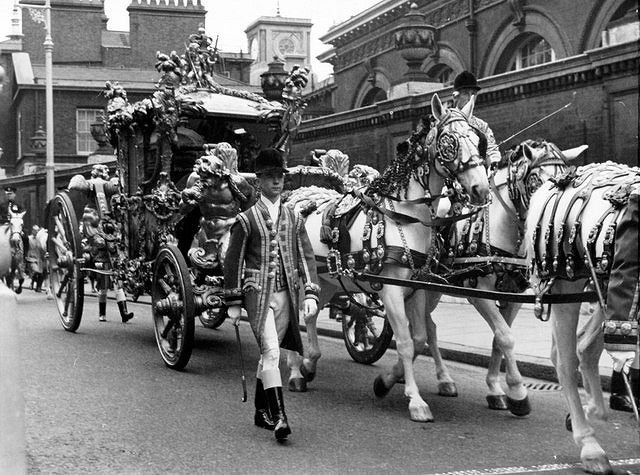
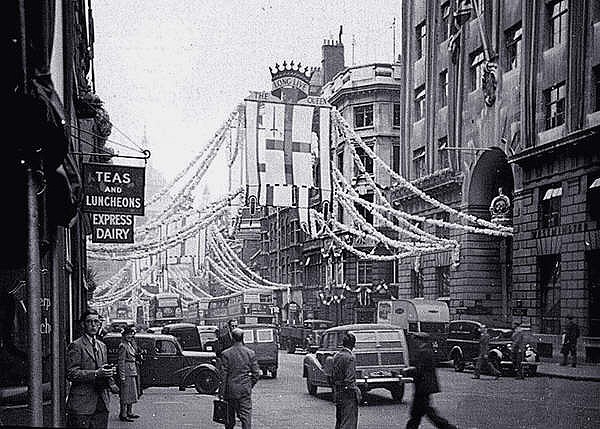
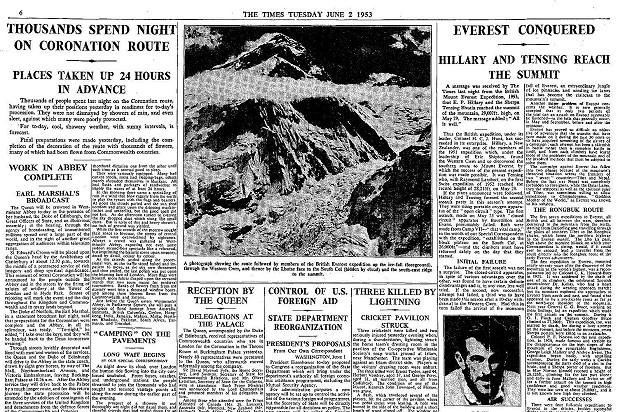
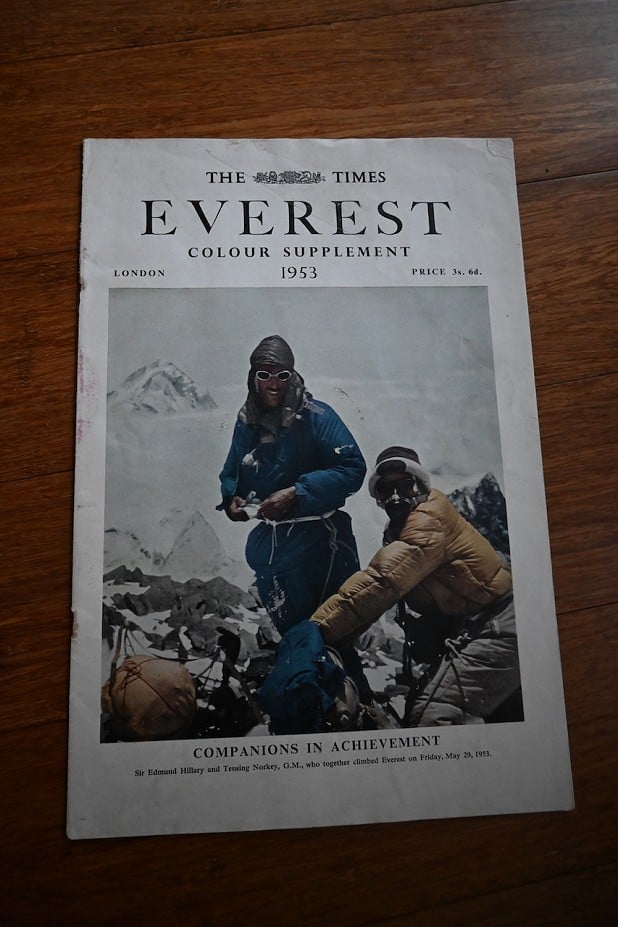
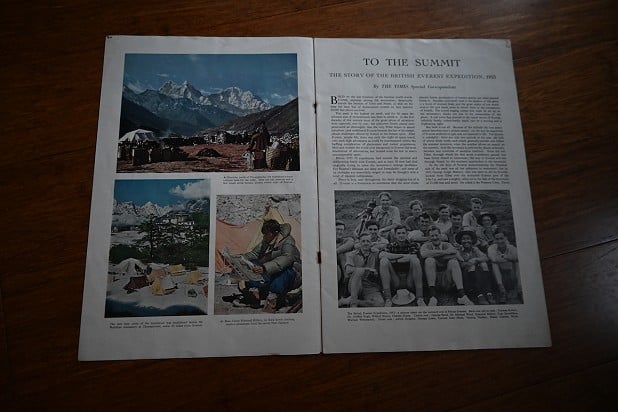
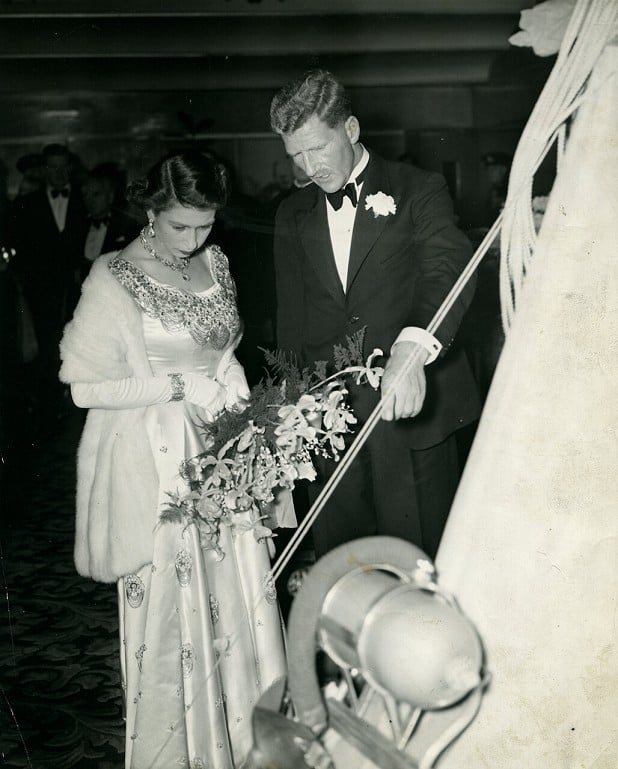
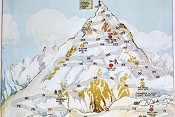
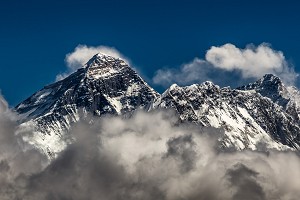
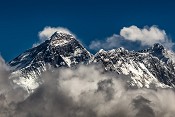
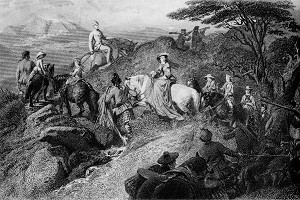





Comments
The Times Everest supplement has its front page with a "tensing norkey GM" as one of the successful climbers! What is this exactly? They got both of his names wrong!
She wasn't "coronated", she was crowned. I watched it on telly. Where the hell has this ridiculous new word suddenly popped up from?
SARS CoV 2?
She throned 😀
I originally had 'crowned', but it was a bit stilted with 'crowds' coming just after. Seems like it still has some modern usage in the news. Crowned/people sounds less clunky though, thanks!